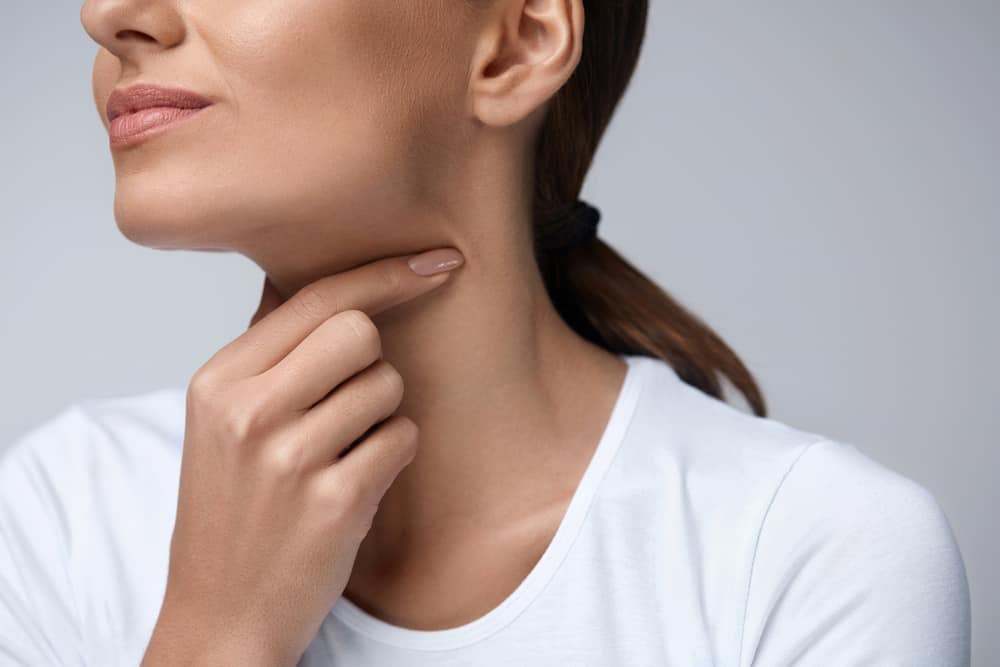Contents:
Medical Video: Physio Neck Exercises Stretch & Relieve Routine
It's no longer new news if sitting for long is not good for your health. Moreover, coupled with many hours glaring at the computer screen during the day's work, many of us complained of back pain and neck muscle pain due to sitting posture when typing tend to bend or office chairs that do not support posture.
The habit of rarely moving not only damages your physical body, but also affects your mental and psychological. Sitting down and keep looking down makes you feel weak, which decreases self-confidence, energy, and mood. As a result? The level of work productivity is not optimal.
So, rather than stinging pain and stiffness while in the office, try the following 10 yoga poses to stretch the body that you can do between the piles of work. Not only does it free the body from tension, the mind will also be refreshed and energized, making it easier for you to stay focused on your work
1. Side Stretch
Position: Stand in front of the table
Stand with both feet close together and both hands on the side of the body. Balance your body weight on both feet. Take a breath, stretch your back and lift your hands straight above your head. Hold your right wrist with your left hand. Keep your shoulders and hips parallel when you tilt your body to the left. Gently pull with your left hand to stretch the right side of your body. Keep the chin up and parallel to the floor. Hold this yoga pose three times to exhale, then exchange the right side.
This pose helps create a lever from the pelvis to your shoulders and neck, so that it stretches the spine and extends the range of motion of both sides of the body
This movement can help you stay upright and look tall when sitting.
2. Shoulder Stretch
Position: Stand in front of the table
Stand with your legs parallel to your hips, and position your toes straight ahead. Hook your fingers behind your back. While you take a breath, stretch your legs, stretch your upper body, and pull your shoulders back. Squeeze your hands and keep them straight behind your back. Exhale and slowly bend the body forward. Keep stretching your back. Lift your shoulders and pull the upper back.
This stretching position serves to straighten and open the shoulders and bent back
3. Neck Stretch
Position: Stand in front of the table
Stand with your legs parallel to your hips, and position your toes straight ahead. Plunge your feet firmly on the floor, placing your body weight on your heels and your spine evenly. Hook your fingers behind your back with one hand reaching from above, while the other reaching from below. Inhale, stretch your back so that your shoulders are parallel to the base of the neck and parallel to the width of your back. Slowly, tilt your head to the left. Relax your jaw and your vision. Hold this stretch for three breaths, and change position.
This stretch pose is an efficient way to relieve tension in the neck and shoulders.
4. Thigh Stretch
Position: Stand in front of the table
Standing facing the table with both feet straight facing forward, both arms are next to the body touching the thigh. Stack your weight on your right leg and lift your left leg to your back. Hold the end of the left leg with your left hand, and slide your left foot towards your right side. Kick your left leg outward, straighten your feet and stretch your fingers back. Hold this stretch for three breaths, and change position.
This stretch pose is useful for opening your thighs and relieving back pain. When you sit, your thighs expand outwards. This position will shrink the hips into the body and shrink the lower back. When you open your thighs, you return your feet back to your hip joint. Stretching is very important to build a healthy lift for your back.
5. Seated Pidgeon
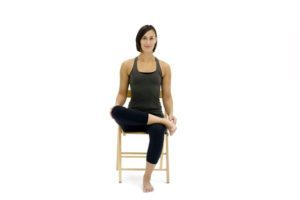
Position: sit on the chair
Sit at the end of the chair. Keep your foot firmly on the floor. Lift your right calf and place it on your left thigh while flexing your right leg. Press your left hand into the palm of your right foot, while also giving constant pressure on your right foot to fight the pressure of your left hand to continue to flex your legs. Pull your inner thighs back and create stretches on your hips and lower back. Stretch your spine and take a deep breath. Repeat for the other side.
This stretching pose will open the hips while overcoming stiff aches in the lower back and hips. When you open your hips, you "rearrange" your hips back to their original joints to get a more stable lift on your lower back. This pose helps create a healthy sitting posture.
6. Chair Cat-Cow Stretch
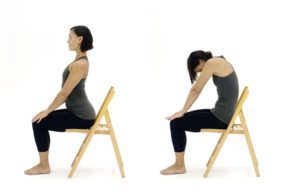
Position: sit on the chair
Sit in a chair by stretching your spine and positioning your feet firmly on the floor. Position both hands above the knees or on the thighs. Take a breath while arching your back outward and lowering your shoulders towards your back, so that your shoulder blades position into your back. When exhaling, bend your back inward (like a bent position) and drop your chin to the chest, so that the position of the shoulders and head are directed towards the body. Do these two positions alternately for five times the breath-pull count.
This stretching pose is useful for your hip joint sockets because your sitting bone moves back and forth following the motion of the spine, to bring the focus of movement to the socket, which can become stiff due to sitting too long.
7. Chair Raised Hands Pose
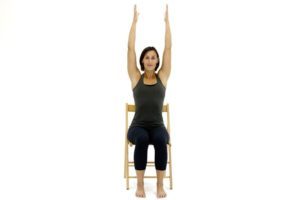
Position: sit on the chair
Sit in a chair by stretching your spine and positioning your feet firmly on the floor. In the breath, lift both hands straight towards the roof ceiling. Relax your shoulder blades into your back while you reach up with the tips of your fingers. Focus your weight on the sitting bones and make the hand movements reach upwards. Hold movement for three breaths, and repeat several times.
Alternative pose: sit with your spine straight while taking a deep breath. When exhaling, relax your gaze up and bend your body (upper back and chest) slightly backwards. Hold the pose for a few seconds, lower both hands to the side of your body, and repeat from the beginning for several times.
This stretch pose helps improve overall posture and stretches your back.
8. Seated Twist
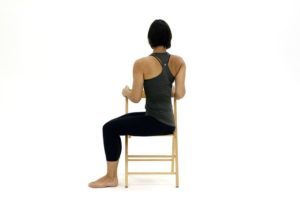
Position: sit on the chair
Sit in a chair by stretching your spine and positioning your feet firmly on the floor. Take a breath and breath, turn your upper body to the opposite side (for example, rotate the left side of the body to the right) from the tip of your spine, holding the armrest. Make a few breaths for a few moments, then turn back to the other side.
This stretch pose helps relieve tension in the back due to bending and sitting too long, also helps facilitate the digestive system of the body.
9. Wrist Release
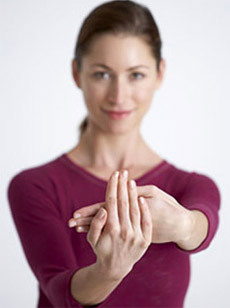
Position: sit on the chair
Use your left hand to press the tips of your right finger down for a few seconds, bending the wrist in the opposite direction by pressing your fingers in the direction of the wrist. Then change position with your left hand pressing the back of your right hand. Hold for a few seconds, then exchange with the other hand.
To really let go of all the tension in your arms, position your arms like a cactus and shake both wrists quickly to the right and left, and up and down.
10. Chair Eagle
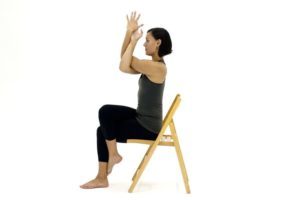
Position: sit on the chair
Sit in a chair by stretching your spine and positioning your feet firmly on the floor. Cross your right thigh over your left thigh. If you can, wrap your right leg around the left calf. Cross your left arm over the right arm, right on the elbow support. Bend your elbows and touch your palms together. Lift your elbows while lowering your shoulders away from your ears. Hold 3-5 breaths. Switch positions of arms and legs, and repeat the count.
This pose opens the shoulder joint, creating a space between the two shoulder bones. In addition, Chair Eagle poses are also useful for increasing blood circulation to each body joint, facilitating the digestive system and secretions, and strengthening the arms, legs, lungs and wrists. This pose also focuses stretching on the upper and lower body evenly at the same time. The more you relax the muscles at each breath, the more optimal the stretching effect.
READ ALSO:
- Choose yoga or pilates?
- Besides sitting in a chair, what other things can be used to support yoga?
- There are many types of yoga. Where do you start?




